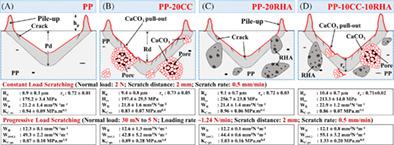当前位置:
X-MOL 学术
›
Polym. Compos.
›
论文详情
Our official English website, www.x-mol.net, welcomes your
feedback! (Note: you will need to create a separate account there.)
Damage mechanics of polypropylene‐based composites using progressive‐ and constant‐load scratching
Polymer Composites ( IF 4.8 ) Pub Date : 2020-06-16 , DOI: 10.1002/pc.25680 Ariharan S. 1 , Rita Maurya 2 , Rajeev Kumar Sharma 1 , Vinod Kumar Sharma 3 , Siddarth Lohia 3 , Kantesh Balani 1
Polymer Composites ( IF 4.8 ) Pub Date : 2020-06-16 , DOI: 10.1002/pc.25680 Ariharan S. 1 , Rita Maurya 2 , Rajeev Kumar Sharma 1 , Vinod Kumar Sharma 3 , Siddarth Lohia 3 , Kantesh Balani 1
Affiliation

|
Polypropylene (PP)‐based composites with reinforcements of CaCO3and rice husk ash (RHA, agricultural waste) are extensively used in textile industry and manufacturing of plastic yarns, tapes, etc. Tribological properties of the PP‐CaCO3‐RHA based composite are studied using constant‐ and progressive‐load scratching. The progressive load scratching depicts a transient‐state interaction, whereas, constant load scratching depicts steady‐state of wear, hence, both modes of scratching are reported to highlight the aspects of damage initiation and damage tolerance on PP‐based composites. The average scratch hardness and toughness of the PP composites improved with reinforcement in both modes of scratching. The reinforcement of 20 wt% RHA and 10 wt% RHA with 10 wt% CaCO3 in PP matrix, marginally improves (0.8%‐1.6%) the wear resistance (wear rate, WR of 12.1‐12.2 mm3 N−1 m−1) during the progressive load scratching compared to that of pure PP (12.3 mm3 N−1 m−1). Poor wear resistance (WR = 12.6 mm3 N−1 m−1) with the addition of 20 wt% CaCO3 in PP matrix during the progressive wear is attributed to poor adhesion (adhesion factor: 0.61) of CaCO3 with PP. Also, an over estimation (3.4‐4.6 times) of wear rate is attributed to high recovery (0.63‐0.77) and the plastic deformation ahead of the scratch tip in the PP‐based composite with viscoelastic nature. High‐wear rate with CaCO3 agglomerate with poor sinterability at 200 °C can be substituted with the strong adhesive nature of RHA (bimodal pore distribution) in PP matrix to achieve optimal hardness, elastic modulus, and scratch resistance.
中文翻译:

基于渐进式和恒定载荷刮擦的聚丙烯基复合材料的损伤机理
带有CaCO 3和稻壳灰(RHA,农业废料)增强材料的聚丙烯(PP)基复合材料被广泛用于纺织工业和塑料纱线,胶带等的制造。PP ‐CaCO 3 ‐ RHA基复合材料的摩擦学性能使用恒定负载和渐进负载刮擦进行研究。渐进式载荷刮擦描绘了瞬态相互作用,而恒定载荷刮擦描绘了磨损的稳态,因此,据报道,两种刮擦模式都突出了基于PP的复合材料的破坏引发和破坏耐受性。两种刮擦方式下的增强均可以改善PP复合材料的平均刮擦硬度和韧性。20 wt%RHA和10 wt%RHA与10 wt%CaCO 3的增强与纯PP(12.3 mm 3)相比,在渐进式负载刮擦过程中,PP基体中的耐磨性(磨损率,W R为12.1-12.2 mm 3 N -1 m -1)略有提高(0.8%-1.6%)N -1 m -1)。在渐进磨损过程中,在PP基体中添加20 wt%的CaCO 3时,耐磨性较差(W R = 12.6 mm 3 N -1 m -1)是由于CaCO 3的粘附性差(粘附因子:0.61)与PP。同样,磨损率的高估(3.4-4.6倍)归因于高回复率(0.63-0.77)和具有粘弹性的PP基复合材料在划痕尖端之前的塑性变形。在200°C下烧结性能差的CaCO 3附聚物的高磨损率可以用PP基体中的RHA(双峰孔分布)的强粘合性代替,以实现最佳的硬度,弹性模量和耐刮擦性。
更新日期:2020-06-16
中文翻译:

基于渐进式和恒定载荷刮擦的聚丙烯基复合材料的损伤机理
带有CaCO 3和稻壳灰(RHA,农业废料)增强材料的聚丙烯(PP)基复合材料被广泛用于纺织工业和塑料纱线,胶带等的制造。PP ‐CaCO 3 ‐ RHA基复合材料的摩擦学性能使用恒定负载和渐进负载刮擦进行研究。渐进式载荷刮擦描绘了瞬态相互作用,而恒定载荷刮擦描绘了磨损的稳态,因此,据报道,两种刮擦模式都突出了基于PP的复合材料的破坏引发和破坏耐受性。两种刮擦方式下的增强均可以改善PP复合材料的平均刮擦硬度和韧性。20 wt%RHA和10 wt%RHA与10 wt%CaCO 3的增强与纯PP(12.3 mm 3)相比,在渐进式负载刮擦过程中,PP基体中的耐磨性(磨损率,W R为12.1-12.2 mm 3 N -1 m -1)略有提高(0.8%-1.6%)N -1 m -1)。在渐进磨损过程中,在PP基体中添加20 wt%的CaCO 3时,耐磨性较差(W R = 12.6 mm 3 N -1 m -1)是由于CaCO 3的粘附性差(粘附因子:0.61)与PP。同样,磨损率的高估(3.4-4.6倍)归因于高回复率(0.63-0.77)和具有粘弹性的PP基复合材料在划痕尖端之前的塑性变形。在200°C下烧结性能差的CaCO 3附聚物的高磨损率可以用PP基体中的RHA(双峰孔分布)的强粘合性代替,以实现最佳的硬度,弹性模量和耐刮擦性。










































 京公网安备 11010802027423号
京公网安备 11010802027423号